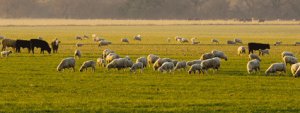
Sheep numbers have fallen again in New Zealand
NEW Zealand’s 2016 spring lamb crop is expected to fall 2.9 percent below the 2015 turn-off to about 23.3 million.
Beef + Lamb New Zealand’s latest stock number survey said that although a warmer winter has resulted in more favourable climatic conditions, the expected lamb crop is estimated to be lower.
New Zealand sheep farmers marked 23.9m lambs in the spring of 2015 – the smallest lamb crop in nearly 60 years — which was down 6.7pc (-1.73 million) on the previous spring.
Beef + Lamb New Zealand chief operating officer, Cros Spooner, said ewe condition and scanning results have been variable across New Zealand and the lamb crop is expected to be down by 2.9pc, to 23.3 million – 0.7 million fewer than last season.
“This is the result of several factors, including fewer breeding ewes and higher empty rates, which will reduce lambs born to ewes mated,” he said.
The latest Beef + Lamb NZ stock number survey showed that New Zealand’s sheep flock decreased 3 percent to 28.3 million in 2015-16, as the beef cattle herd increased by 2.8pc to 3.7 million.
The 2015–16 year has been an exceptionally trying farming season, with facial eczema in the North Island and widespread climatic challenges in other parts of the country – particularly North Canterbury. Other reasons for the declining NZ sheep flock include weak lamb prices, strong beef cattle returns, seasonal conditions and uncertainty over environmental regulations. New Zealand’s dairy herd to be almost unchanged, down about 1pc percent to 6.4 million as at June 30, 2016.
Mr Spooner, said breeding ewe numbers fell across all regions of New Zealand. They were down by 3.1pc overall – but the largest drop was in Marlborough and Canterbury — down 6.5pc — due to the ongoing drought conditions.
“North Island ewe numbers decreased 2.9pc to 9 million, with drought conditions and facial eczema a significant cause.
“South Island numbers dropped 3.3pc to 9.5 million, also affected significantly by drought,” he said.
“Reducing capital stock numbers is often the least preferred option for farmers, so it does reflect a very challenging year.”
Mr Spooner said the national hogget flock is also down on last year.
“Hogget numbers decreased 3pc to 8.9 million, but the fall was most dramatic in the North Island – down 6.9pc.
“On the east coast, some of the decrease was driven by a reduced lambing percentage in spring 2015 and the influence of dry conditions, forcing destocking in autumn 2016.”
In Taranaki–Manawatu, lambs were finished earlier in response to the conditions, leading to fewer head on hand at season close, Mr Spooner said. Marlborough and Canterbury hogget numbers increased by 4.8pc, with higher numbers of bought-in trade hoggets held at season end.
Increase in weaner beef cattle, but declining breeding herd
Mr Spooner said the 2.8pc increase in beef cattle numbers followed a 3.3pc decline in the 2014–15 season.
The largest contributor to the increase in cattle numbers was a lift in weaner cattle across many regions, up 8.2pc as farmers responded to good returns. The exception to the increased weaner numbers trend was on the east coast of the North Island, which experienced dry weather conditions, Mr Spooner said.
“There was a continuing decline in the beef breeding herd, down by 1.6pc, and this reflects the trend to more flexible cattle systems.
“This reinforces the need for better integration with the dairy industry – particularly with genetics, which is a key area of focus for Beef + Lamb New Zealand.”
Mr Spooner said many farmers would want to have more stock on hand at this time of year. However, a combination of dairy farmers rearing more replacements themselves (normally grazed on sheep and beef farms), climatic conditions that have led to early sales of stock, lower pasture covers in some regions and in some cases a shortage of available replacement stock, are all factors. The challenge for farmers will be maximising the performance of animals on hand and secondly, as farming conditions allow, finding profitable stock classes to restock with, Beef + Lamb NZ said.
Beef + Lamb New Zealand said it will be working with its regionally-based farmer council to provide relevant information to assist farmers with these decisions. This included a significant focus on proactively managing the ongoing impact of last season’s facial eczema outbreak.
About the Stock Number Survey
Beef + Lamb New Zealand’s Economic Service carries out a stock number survey annually. The latest survey figures are for the year to June 30, 2016. Beef + Lamb New Zealand’s Economic Service is recognised as the best source of statistical information for the New Zealand sheep and beef sector.
Read the full report
Source: Beef + Lamb New Zealand.

HAVE YOUR SAY